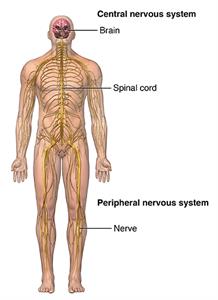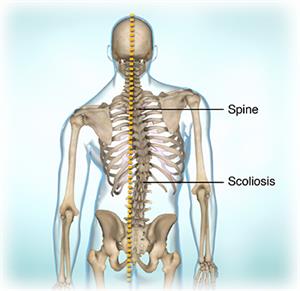Friedreich's Ataxia
Friedreich's Ataxia
What is Friedreich's ataxia?
Friedreich’s ataxia is a rare, inherited, degenerative disease. It damages the spinal cord, peripheral nerves, and the cerebellum portion of the brain. This conditions tends to develop in children and teens and gradually worsens over time. Unsteady, awkward movements and a loss of sensation due to nerve injury develop as the disease progresses.
The condition is named after Nicholaus Friedreich, the German doctor who discovered it in the 1860s. Ataxia means impaired and uncoordinated muscle movement resulting in gait imbalance
What causes Friedreich's ataxia?
Friedreich's ataxia is an inherited condition caused by a defect in a gene called FXN. It is a recessive genetic disorder. This means you need to inherit a copy of the gene defect from both parents to develop it.
What are the symptoms of Friedreich's ataxia?
Symptoms of Friedreich's ataxia often start between ages 5 and 15, although they can develop later in life. Physical symptoms include:
- Trouble walking
- Tiredness
- A loss of sensation that starts in the legs and spreads to the arms and trunk
- Loss of reflexes
- Slow or slurred speech
- Hearing loss
- Vision loss
- Chest pain
- Shortness of breath
- Heart palpitations
These symptoms might be due to nerve damage. Or, they may be from the heart problems that tend to develop in people with this disease. Many people eventually develop scoliosis (a curving of the spine to one side) or foot deformities, which often require surgery. Some also develop diabetes.
Symptoms from Friedreich's ataxia tend to get worse over time.
How is Friedreich's ataxia diagnosed?
To diagnose Friedreich's ataxia, your doctor will take your medical history and do a physical exam. Specific tests to diagnose this condition may include:
- Checking your reflexes, balance, and nerve sensation
- Blood tests
- Imaging scans such as an MRI (magnetic resonance imaging) or a CT (computed tomography)
- Nerve conduction studies that use electrical impulses to check nerve activity
- Heart tests
- Genetic tests to identify the defective gene causing the disorder
How is Friedreich's ataxia treated?
There is no cure for Friedreich's ataxia, but some potentially breakthrough treatments are under study.
Treatment focuses on minimizing symptoms and maintaining comfort and function for as long as possible. Options include braces to bolster the arms, legs, feet, or spine; physical therapy; speech therapy; occupational therapy; and surgery to correct skeletal problems.
You may need medicines if you develop heart problems or diabetes.
Living with Friedreich's ataxia
Like other degenerative nervous system diseases, Friedreich's ataxia tends to progress over time, but the course can vary among different people. Treatment can often help limit symptoms and keep this condition under control for as long as possible.
As the disease progresses, it often leads to scoliosis — an abnormal curvature of the spine — or foot deformities, for which you might need surgery.
It can also cause heart problems, due to weakened heart muscle and disturbances in the electrical system of your heart. Some people with this disease develop diabetes. It is important to follow your healthcare provider's advice to help limit the effects of these complications.
Because of the effects of Friedreich's ataxia on the nervous system and other organs, many people will need to be in a wheelchair within 10 to 20 years. Slurred speech, hearing loss, and vision problems can occur as the disease progresses, as well. Some people might die from heart failure or other complications. However, some people live into their 70s or beyond.
In people with permanent physical impairments, physical therapy can be very important in helping maintain or increase strength and improve coordination. Another type of therapy is occupational therapy. This therapy teaches new ways of doing everyday tasks in spite of physical limitations. Speech therapy can also be helpful if speech is affected.
Finally, some people with physical disabilities can feel sad or depressed. Antidepressants and psychotherapy, or “talk therapy,” are both available to help treat depression.
When should I call my healthcare provider?
If you have been diagnosed with Friedreich's ataxia, talk with your healthcare provider about when you might need to call them. They will likely advise you to call if you notice worsening of any symptoms or if you develop any new symptoms.
Key points
- Friedreich’s ataxia is an inherited disorder that affects some of the body’s nerves. It is caused by a gene defect that is inherited from both parents.
- Symptoms often begin in late childhood and can include trouble walking, fatigue, changes in sensation, and slowed speech. These tend to get worse over time. Heart disease, skeletal problems, and diabetes can also occur.
- Friedreich's ataxia can't be cured at this time, but newer treatments are now being studied. Current treatments such as surgery and physical, occupational, and speech therapy are aimed at keeping the disease in check for as long as possible. Medicines are often used to treat heart disease or diabetes.
Next steps
Tips to help you get the most from a visit to your healthcare provider:
- Know the reason for your visit and what you want to happen.
- Before your visit, write down questions you want answered.
- Bring someone with you to help you ask questions and remember what your provider tells you.
- At the visit, write down the name of a new diagnosis, and any new medicines, treatments, or tests. Also write down any new instructions your provider gives you.
- Know why a new medicine or treatment is prescribed, and how it will help you. Also know what the side effects are.
- Ask if your condition can be treated in other ways.
- Know why a test or procedure is recommended and what the results could mean.
- Know what to expect if you do not take the medicine or have the test or procedure.
- If you have a follow-up appointment, write down the date, time, and purpose for that visit.
- Know how you can contact your provider if you have questions.
Updated:
April 07, 2017
Reviewed By:
Dozier, Tennille, RN, BSN, RDMS,Shelat, Amit, MD

